They are in great demand among consumers. However, solid-state models are still popular. They operate on various types of fuel, but briquettes are one of the most environmentally friendly and inexpensive energy sources for them.
Before considering briquettes for heating and their varieties in more detail, it is necessary to note their relevance. They can be used in a wide variety of situations:
- Ensuring the operability of central boiler houses
- Heating of warehouses, production halls and farms
- Maintaining combustion in ovens, barbecues and
- Heating of private residential buildings, etc.
Method for the production of briquettes
Fuel briquettes can be produced different methods... From the method of briquetting, they are divided into the following four categories:
- Pellets
- Pini & kay
- NESTRO
Pellets
Pellets became widespread. They are granules that do not exceed a few centimeters in size. Waste of various wood species are used for their production.
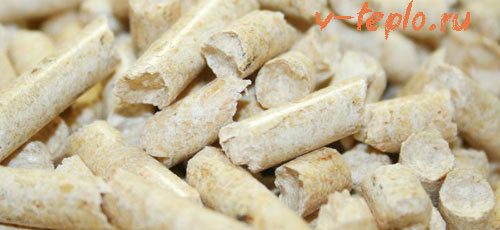
One of the disadvantages of pellets is the need for special boilers. long burning to burn them. In classic equipment with uncontrolled oxygen access, they will burn very quickly and are unlikely to bring the expected benefits and benefits.
Representing hexagonal cylinders, Pini & Kay heating briquettes are the most technologically advanced among the above varieties. They have a rounded hole in the center. Thanks to the additional distribution of air flows inside it, it was possible to achieve uniform combustion.

Pini & Kay briquettes are widely used for burning in fireplaces. They are distinguished by the most beautiful aesthetic appearance, being the source of a beautiful and even fire.
Video review Pini Kay
The average cost is about 8000 rubles. per ton
The most common are RUF briquettes. They can be made from small particles and even dust, which are pressed into rectangular or square products.
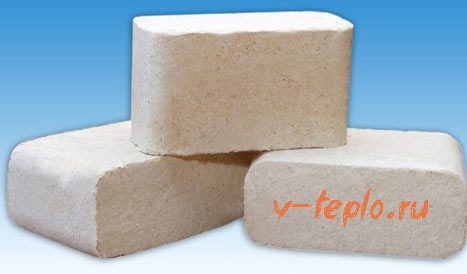
RUF-briquettes have a lot of advantages, among which are:
- Ease of use
- Ease of storage and storage
- High thermal conductivity
- No harmful binders in the composition
Video review
Briquettes of this shape and structure are capable of smoldering for the longest time in classic solid-state boilers. Due to their high density, they can be stored in high humidity conditions for an unlimited time period. Even though the cost is more significant compared to other types, the price per unit of heat is lower. average price 6000 rub per ton
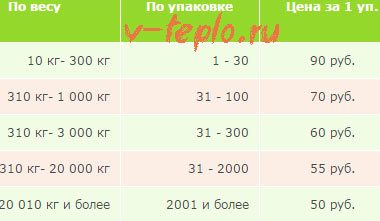
Fuel briquettes NESTRO, unlike other varieties, are made exclusively from large sawdust, which are tightly pressed by a mechanical method. They are the cheapest among the considered varieties, since they do not need the use of special equipment during the production process.
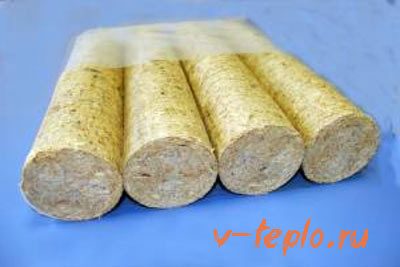
Among the disadvantages are:
- Easily crumbled in case of improper transportation
- Burn out quickly
- Can only be stored in rooms with low humidity
Combustion video
NESTRO briquettes can look like Pini & Kay and have a similar hole in the center. However, during the manufacturing process, they are not processed with high temperatures, as a result of which they do not allow obtaining an even fire for a long time.
The average cost is about 7,500 rubles. per ton
Raw materials used
For the manufacture of heating briquettes are used different kinds raw materials. Most often they are made from waste products from various industries. Among the many varieties, the most common are:
- Coal
- Wood
Coal
Artificial solid fuel can be made from coal screenings. A special binder is added to the crushed raw materials and pressed under the influence of high temperatures. The resulting molds are convenient for transportation and subsequent storage. They are capable of emitting about 5000 kcal / kg of energy.
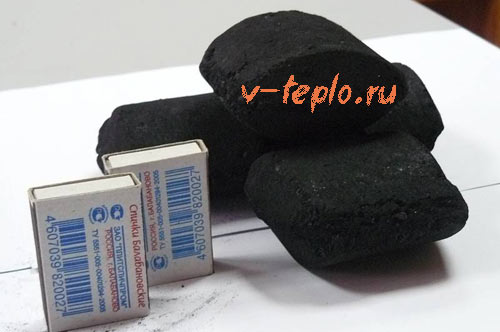
One of the main advantages of using coal-based briquettes is environmental safety. Coal is classified as a smokeless compound because it does not emit large amounts of carbon monoxide into the environment. Due to this property, it can be used in the cooking process.
The average cost of products on the market is from 3-5 thousand per ton.
For the manufacture of peat briquettes, the crushed raw materials must be dried with high quality. Small particles are first heated and then pressed. After exposure to high pressure, bricks convenient for storage and use are obtained.
The scope of application of peat briquettes is very wide: from open fires to any kind of solid-state boilers. Long-term burning and high thermal energy output make the product the main alternative to wood.
![]()
One of the distinctive features of peat briquettes is that the ash obtained after combustion can be used as fertilizer. It does not need to be recycled, being used in favor of summer residents.
Peat briquettes are most effective for heating in boilers, which have the ability to limit the access of oxygen to the inside of the furnace (long-burning furnace). In them, one load can smolder up to 12 hours, for example, keeping the house warm throughout the night.
Nowadays the average price of peat briquettes is 5-6 thousand rubles per ton.
Wood
The most common and demanded among buyers are fuel briquettes, which are made from waste from the woodworking industry. In the production process, not condition, dead wood, sawdust or shavings are used.

In the production process, natural wood briquettes are not added to the raw material with additional adhesive components. The particles stick together due to ligin, which is released under the influence of elevated temperatures.
If we compare wood heating briquettes with natural wood, the former have a number of significant advantages:
- Constant density and homogeneity (about 1200 kg / m3)
- Heat generation is much higher (about 4400 kcal / kg)
- Low moisture content (no more than 10%)
- Almost no ash remains after combustion (about 1-3%)

Unlike natural firewood, pressed wood briquettes do not emit unpleasant crackles during combustion. One bookmark should be enough for at least 3-4 hours, while a constant temperature will be maintained inside the furnace.
The coals that form after combustion can be reused as fuel for the barbecue. The emitted smoke contains practically no carbon monoxide, which makes it safe for human health. Another advantage of pressed wood briquettes in comparison with classic wood firewood is that they are distributed in the market in kilograms.
It is also worth noting that by burning wood briquettes for heating, a minimum amount of carbon dioxide is emitted into the environment. It is comparable to that of natural wood decomposition.
The average cost on the market is from 2 thousand rubles per ton.
Production and storage of heating briquettes
After processing, briquettes, during combustion, generate a large amount of heat over a long period of time. This figure is almost comparable to the heat generated by burning classic bituminous coal.
Plants for the production of briquettes, as a rule, are located in the vicinity of the places where raw materials are obtained. Thus, there is no need to take into account the costly transportation between them, which has a positive effect on the cost of production and, as a result, the market price.
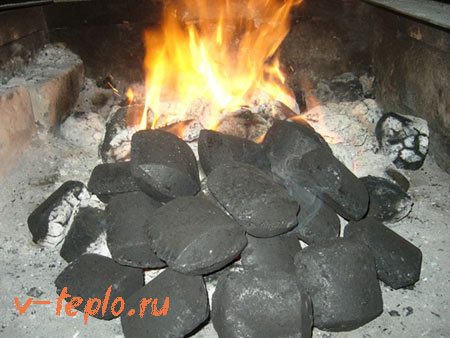
To prevent heating briquettes from losing their properties, it is necessary to follow the basic storage rules:
- Despite the high density of products, it is recommended to store them in places where the humidity does not exceed 80%
- In winter, it is recommended to stack briquettes indoors, excluding rainfall
- Briquettes are not able to ignite spontaneously, so there is no need to strictly adhere to fire safety precautions
Summing up
If a solid-state boiler is installed in a house, garage or warehouse, it is imperative to purchase briquettes for heating. They are more often used as an additional fuel, stacking in the furnace after burning the main one to maintain the combustion for a maximum duration.

Fuel briquettes - Euro wood from 6000 rubles per ton.
Fuel briquettes are an economical type of fuel that has been popular for a long time as a fuel for heating homes. Wood fuel briquettes for heating, have various shapes, are pressed under high pressure under high temperature, they do not contain harmful substances... Compared to conventional solid fuels such as coal, they are odorless and there are no harmful substances such as sulfur in the flue gases.
Eurodrova - briquettes from sawdust and other waste wood production, which are used in central heating boilers. They are perfect for fireplaces and boiler rooms. One of the important positive differences is a constant combustion temperature for a long time, which allows them to be put into the furnace much less often. Commercially-scaled incineration may require large sums of money to install additional equipment to disperse pollutants. Ashes and slag are practically not formed during incineration (maximum 1%) and ash is an excellent fertilizer. When burning coal, it is necessary not only to clean the furnace furnace from slag (maximum 40%), but also to transport it to specially equipped landfills, which will constantly require expenses.
Technical characteristics of our fuel briquettes.
Our fuel briquettes are made from fine sawdust of a mix of 50% birch and 50% pine.
- Perfect for baths, all types of fireplaces, stoves, heating boilers, and saunas
- the specific gravity of such biofuel is 1100-1150 kg / m3;
- calorific value varies in the range of 4500 - 5000 Kcal / kg;
- when burning, they do not emit odor, there is no smoke, soot, carbon monoxide and other substances that can cause irreparable harm to the environment and human health;
- due to the constant combustion temperature, the consumer can calculate in advance the required flow rate of a particular room and adjust the most optimal temperature.
How to buy RUF fuel briquettes and eurowood from RufRuf.
We are a manufacturer and offer you to buy cheap eurowood-fuel briquettes ruf at a price of 5 rubles 50 kopecks per 1 kilogram! This is an innovative product that is able to solve any heating problem without compromising the environment and your wallet! Call and order in Moscow, the Moscow region and other regions of Russia at our factory from the manufacturer RufRuf.The price of fuel briquettes and eurowood.
Wholesale cost is discussed individually.
The cost of delivery of fuel briquettes to the districts of Moscow and the Moscow region.
| Area | up to 1.5-2 tons | up to 4.5 tons |
| Dmitrov | from 2500 | from 3500 |
| Vladimir | from 3500 | from 6500 |
| Kaluga highway | from 1800 | from 2800 |
| Istra | from 2500 | from 4000 |
| Ramensky district | from 1800 | from 2800 |
| Mozhaisk | from 3400 | from 6000 |
| Odintsovo | from 2500 | from 3500 |
| Sergiev Posad | from 2500 | from 3500 |
| Cuban | from 3000 | from 4000 |
| Pavlovsky Posad | from 2500 | from 3000 |
| Mytishchi | from 1500 | from 2500 |
| Chekhovsky district | from 2500 | from 3800 |
| Bronnitsy | from 2300 | from 3000 |
| Naro-Fominsk | from 3000 | from 480 0 |
| Korolev | from 1500 | from 2500 |
| Solnechnogorsk | from 2500 | from 2500 |
| Chekhov | from 2500 | from 3500 |
| Balashikha | from 1000 | from 2800 |
| Krasnogorsk | from 2000 | from 2800 |
| Dmitrovsky district | from 1500 | from 2500 |
| Voskresensk | from 2500 | from 3800 |
| Podolsk | from 2300 | from 3000 |
| Kolomna | from 3000 | from 4500 |
| Ramenskoe | from 2000 | from 3000 |
| Ivanteevka | from 2000 | from 2800 |
| Gorky highway | from 1500 | from 2500 |
| Dubna | from 3500 | from 5800 |
| Schelkovo | from 1500 | from 2300 |
| Yaroslavl highway | from 1800 | from 2500 |
| Wedge | from 3000 | from 4500 |
| Lyubertsy | from 1 300 | from 2500 |
| Zelenograd | from 2000 | from 3000 |
| Noginsk district | from 1800 | from 2500 |
| Khimki | from 1800 | from 2500 |
* If your area or settlement is not in the table, then we advise you to order a call and our managers will call you back and tell you the exact cost.
Payment for the goods is as follows.
1. To the driver-courier when unloading at the buyer's site
2. When picking up - payment is made directly at the warehouse
3. When paying by bank transfer, an invoice is issued, you pay and pick up the goods.
Firewood versus fuel briquettes who is "on horseback"?
Heating with wood, it would seem, should have long lost its relevance and sink into oblivion. After all, almost every house has heating systems. However, not all so simple. There are also baths, saunas and fireplaces. It is they who need wood "top dressing". And since this is no longer a necessity, but a rare opportunity to pamper yourself, then you want the appropriate quality. Firewood is the most common material for keeping fires. But they are gradually being replaced by fuel briquettes.
What are fuel briquettes
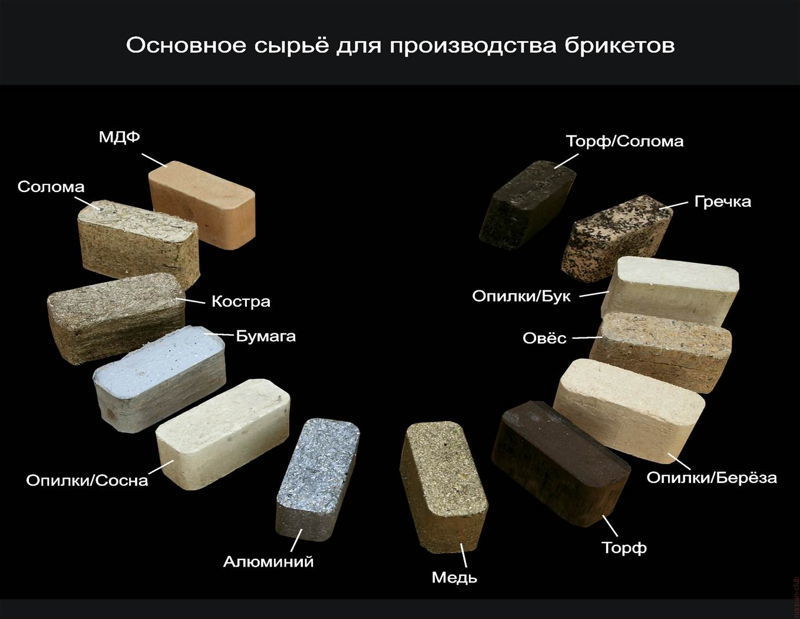
Fuel briquettes, also known as "Eurowood" - is one of the solid fuels, which is made by pressing sawdust and other natural materials under very high pressure. Bonds the constituent parts into a single briquette of lignin contained in any plant. Thus, in the manufacture of Euro wood, neither glue nor any other chemical agents are used that could harm environment.
Types of Euro briquettes
There are two types of fuel briquettes, but the difference between them is not too great:
Eurobriquettes RUF
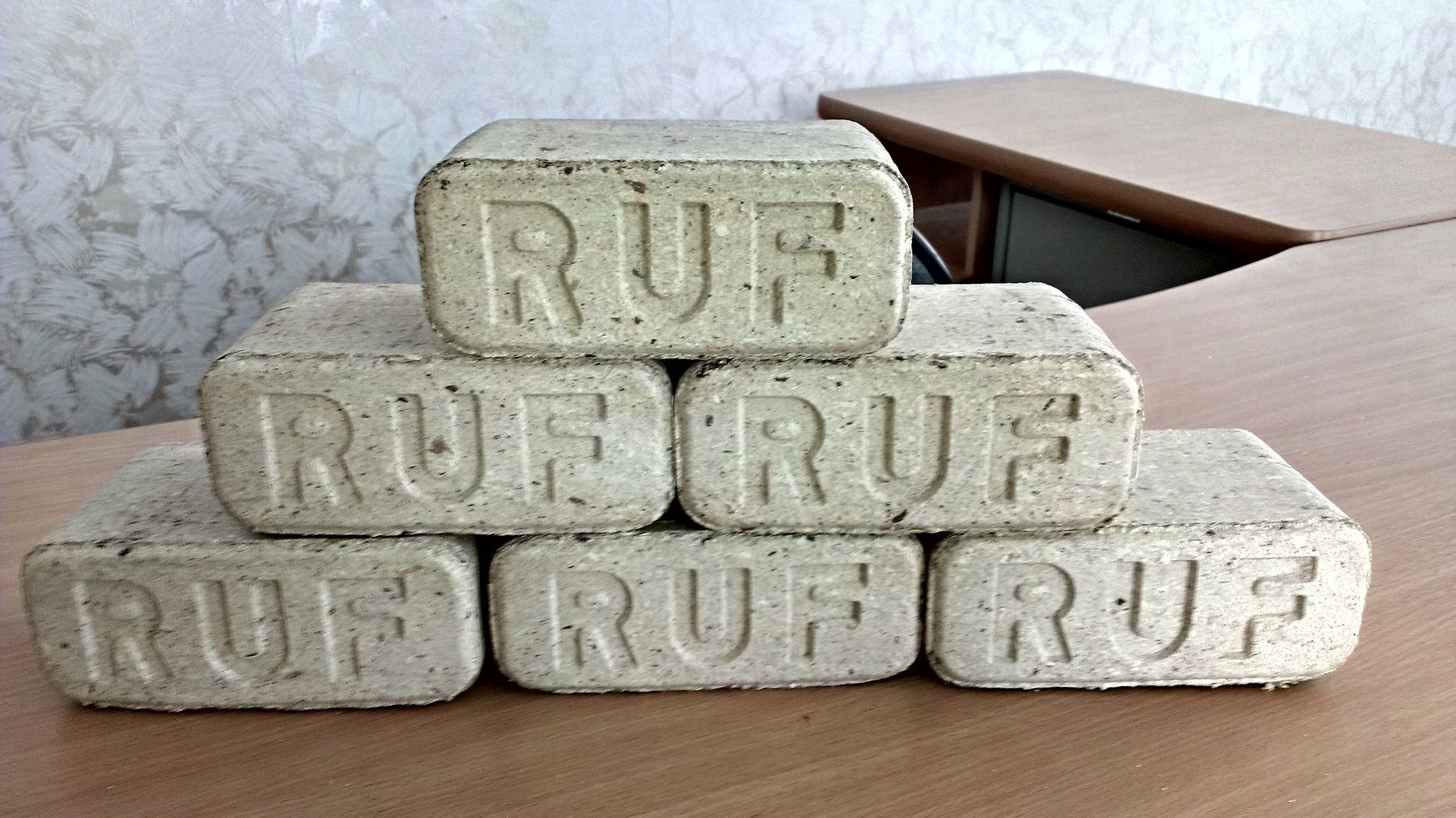
They are made according to the technology described above: chips and sawdust are pressed together, held together by a natural adhesive. Are in the shape of a rectangle. The most optimal option, since they are inexpensive, but the price does not affect the quality in any way.
Pini Cay Eurobriquettes
They are made according to the same principle, but at the final stage they also go through the firing process. As a result, Euro briquettes of this type acquire natural protection against moisture, which guarantees their longer storage.
Due to this, the price for such firewood is higher: the margin is about two thousand rubles per ton. Outwardly, they also do not look like RUF: these firewood have a shape close to an ordinary log, with a through hole.
DIY briquette press
What is better to choose ordinary firewood or "euro"?
Fuel briquettes, like any manufactured product, have both positive and negative sides. Compared with wood, briquettes boast the following advantages:
- They burn on average 4 times longer than ordinary firewood, which allows them to be consumed in much less quantity.
- They burn literally to ash, leaving behind it in an amount of 1% of the original mass of the material. By the way, after the combustion of firewood, coal remains, which is about 20% of the initial amount of material. By the way, the ash from the burnt wood can be used as a fertilizer for the soil: the seedlings in this place will grow better due to the increased amount of potassium.
- Heat dissipation of eurovdvrov is much higher than that of conventional ones: the difference is 2 times.

- They are able to maintain heat literally throughout the entire combustion process. That is, if the heating power of ordinary firewood decreases as it burns, and the coals die out within 15 minutes, then the heat transfer level of Euro wood does not change even when only coals remain from the briquette, which continue to burn for another hour. This property is extremely useful for those who like to go outdoors with a barbecue.
- The fire from burning briquettes does not spark, practically does not emit smoke and smell. Thus, Eurowood does not harm the environment and does not cause discomfort when being near them.
- When burning, Euro-woods do not emit substances that are harmful and hazardous to human health. The fact is that ordinary firewood contains fungi and mold, which die during combustion, but create toxic smoke.
- As a result of the burning of fuel briquettes, soot does not form on the walls of the chimney.
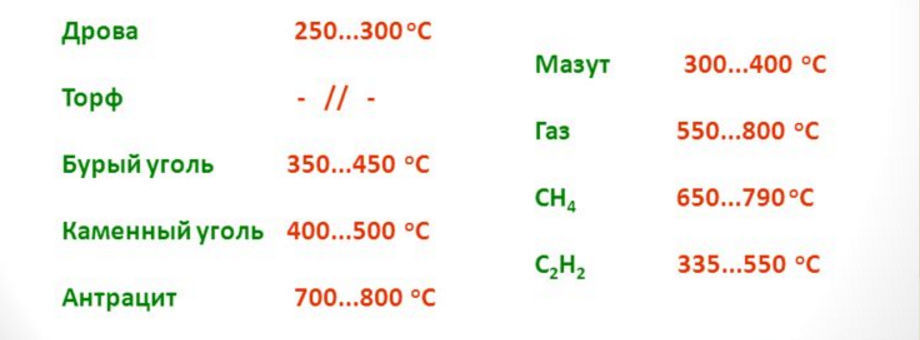
- The compactness of briquettes allows significant savings in space: they are delivered in the form of neatly stacked stacks. Firewood can be of different shapes and sizes, which almost excludes the possibility of folding them neatly. Moreover, firewood is usually "dumped" out of the truck to any free space on the site, after which you will have to transfer it yourself to the shed and spread it there.
In general, all the positive aspects of fuel briquettes could be summed up in one word: efficiency. Although there are several points that distinguish fuel briquettes from ordinary firewood, which are not related to price. For example, one of the very big benefits is cleanliness and order. There is a lot of dust, chips and other debris from ordinary firewood. Briquettes do not have such difficulties. However, does this mean that briquettes are definitely better than firewood?
Advantages of firewood compared to briquettes

- Undoubtedly, briquettes burn longer and emit stable heat, but they emit less heat than firewood. It will not be possible to quickly warm up the room with the help of euro wood, you will have to wait.
- If you want to spend a pleasant evening with a book, a cup strong tea and a crackling fire in the fireplace, you will have to give up fuel briquettes. The fact is that Eurowood does not emit the crackle characteristic of ordinary firewood, which creates that very unique feeling of home warmth. Firewood is able to provide this effect due to the water contained in it and absent in the briquettes.
- No unpleasant smell from ash. The ash remaining after burning firewood does not have a pungent odor, typical for ash from Euro wood.
- Briquettes of normal quality or RUF type can be quite fragile, sometimes even crumble right in the hands. However, there are high quality briquettes, they are stronger. The question is the price!
- Top quality briquettes. They are characterized by high density: 1400 kg per cubic meter. They burn longer, give off more heat and leave a minimum of ash. They have a dense structure without cracks.
- Briquettes are of normal quality. Their density is about 1000 kg per cubic meter, they have a layered structure and are more susceptible to damage. In addition, they have less heat transfer, burn out faster and leave more sediment behind.
The cost of fuel briquettes may vary depending on what quality they are. They can be divided into two groups:
The difference in quality and price appears from the manufacturer's equipment costs: the more the briquette is pressed, the better it will be and the faster the machine on which it is made wears out. This factor of rapid wear is included in the cost of the goods.
Obviously, high quality briquettes will cost more than regular briquettes. But at the same time, even the highest quality briquettes will cost less than conventional ones. birch firewood, and even of the usual quality - and even more so.
If they also seem too expensive, even taking into account the savings compared to firewood, you can make them yourself. To do this, you need to collect all the branches and twigs from the site, mix them with clay and fill with water. There should not be too much water so that the bars can be formed as a result.
The resulting mixture is poured into molds, pressed and left to dry in the sun for several days. Of course, such a product will be significantly inferior to real briquettes, but it will save money. In addition, the site will become cleaner.
So which is better?
Fuel briquettes last longer, take up less space, do not leave debris, are less harmful to the environment and are cheaper than regular firewood. However, nothing beats the soothing crackle of dry birch logs in the fireplace. Yes, and it will not work to heat the room quickly with the help of briquette fuel.
Thus, when making a choice between a fuel briquette and firewood, it is necessary to be guided not only by their characteristics and advantages, but also by your own plans for their use.
Video: How it works - fuel briquettes
Secrets of joint pain treatment from our regular reader.
Hello!
My name is Gennady Alekseevich. I am a stove-maker with over 20 years of experience. I am engaged in both the repair and construction of Russian stoves and fireplaces. I always do the work very efficiently and carefully, which negatively affects the condition of the joints. With age, the pains started getting stronger, up to the point where I could no longer work. Having tried a lot of both medication and folk ways treatment, I realized how serious my disease is, since there was no positive effect. Until I came across one tool that I want to tell you about.
It is a unique blend of the rarest and most powerful natural healing substances. This tool has proven its effectiveness not only for patients, but also for science, which has recognized it as an effective drug. Joint and back pain goes away in 10-15 days, studies have shown. The main thing is to clearly follow the instructions in the methodology. You can order the product in its original packaging with a quality guarantee at
Made from pressed sawdust and shavings.
Fuel briquettes (Euro wood) are modern, convenient solid fuels for all types of stoves, boilers, fireplaces.
1 ton (1.5 cubic meters) of fuel briquettes gives an amount of heat equivalent to 5 cubic meters (dump truck) of naturally dried birch firewood.
Briquettes in packs of 10 kg. in film, on pallets.
1 ton \u003d 100 packs. 1 ton occupies 1m2 of area.
In our company you can buy fuel briquettes in Moscow from one package.
Fuel briquettes price
RUF briquettes (sawdust)
1 package \u003d 10kg
120r / pack
100 rub / pack
from 1 ton
7000r / ton
RUF briquettes (old flour)
1 package \u003d 10kg
130r / package
110r / pack
from 1 ton
8000r / ton
Nielsen (cylinders)
1 package \u003d 10kg
130r / package
110r / pack
from 1 ton
8000r / ton
Pini Kay (bars with a hole)
1 package \u003d 10kg
140 rub / packing
120r / pack
from 1 ton
9000r / ton
Wholesale deliveries of fuel briquettes with delivery throughout Russia.
Low prices for the delivery of fuel briquettes in Moscow and nearby regions (see the DELIVERY section). Free unloading! You can buy fuel briquettes in our company on low prices, as well as European wood wholesale!
Delivery of Eurowood at a time convenient for you, as well as the sale of fuel briquettes by self-pickup from a warehouse in Moscow. You can pick up paid goods from the warehouse in parts. Special conditions for wholesalers. Discounts are provided for fuel briquettes, depending on the volume of the order.
Storage conditions
The shelf life is not limited, but it is necessary to protect Eurodrova from moisture. You should store RUF briquettes, Nielsen briquettes, Pini Kay briquettes indoors (in a barn, garage, under a canopy) or cover with foil.
Characteristics
Heat transfer 4500-5000 kcal / kg,
Humidity<8%,
Density 0.9 - 1.2 g / cm3,
Ash content<1%
EURODROV is more convenient and profitable than firewood and coal, because:
firewood of natural moisture (40-55%) ~ 1500 kcal / kg
dry firewood (moisture 25%) 2160 kcal / kg (pine), 2600 kcal / kg (birch)
brown coal 3910 - 4600 kcal / kg
briquettes from wood waste 4500-5000 kcal / kg
coal anthracite 6100 - 7500 kcal / kg
In terms of heat transfer per unit weight, wood fuel briquettes surpass ordinary firewood by 2-3 times and are practically equal to coal. When buying fuel briquettes at a minimum price (from 1 ton), eurowood will cost you less than the equivalent amount of firewood in terms of heat transfer.
The duration of burning and smoldering is 2-3 times longer than ordinary firewood.
It is always ready-to-use fuel - no need to saw, chop or dry anything.
EURODROVA is a factory product with constant characteristics (weight, moisture). Unlike ordinary firewood, you will not be fooled with volume, moisture, etc. You know exactly how much you are buying and you can buy any required amount of fuel, from one package. And for this reason, the price for Euro wood is more profitable, in contrast to ordinary wood.
Euro wood (including ruf briquettes, pini kay briquettes) is safer - they burn odorlessly, do not shoot or spark, practically do not give off smoke, soot, carbon monoxide and other harmful substances, unlike wood or coal. They are not explosive during storage, unlike gas, diesel fuel, etc.
Convenient and clean packaging. Space saving - 1 ton occupies 1m2 of area, fuel supply can be stored next to the boiler / stove.
When burning euro, firewood (fuel briquettes) form a minimum of ash - 20 times less firewood and 40 times less coal. As a result, cleaning of the stove or fireplace is much easier. Ash can be used as fertilizer.
Fuel briquettes are not subject to mandatory certification in the Russian Federation and therefore the price for fuel briquettes is quite low. Our briquettes are made on German equipment and comply with the DIN standard adopted in Germany. This is confirmed by certificates and conclusions based on the results of various laboratory tests.
Comparison of fuel briquettes with other fuels
Calorific value:
Ash content:
combustion of brown coal produces 40% ash
combustion of black coal produces 20% ash
when wood briquettes are burned, 0.5-1% ash appears
Ash from Eurodroves can be further used as mineral fertilizer.
CO2 release during combustion of briquettes:
10 times less than natural gas
30 times less than coke
50 times less than coal
Boiler power when using Euro wood increases up to 50% compared to ordinary wood.
Emission of sulfur during the combustion of Eurodrove<0,08%, что позволяет в 3-4 раза реже чистить дымоход, чем при использовании дров или угля. Существенная экономия на услугах трубочиста!
Eurodrops are produced at high pressure and temperature. The binder is lignin, which is found in the wood itself.
The duration of burning and smoldering of briquettes is on average 2-3 times longer than that of ordinary firewood, they also ensure a constant temperature during combustion. This means that compared to conventional wood, the stove can be loaded 2-3 times less often. Briquettes are easier to feed into the combustion chamber than wood and coal. They flare up well, burn for a long time and evenly, do not give off sparks and soot.
Eurodrops are well suited for barbecue or grilling. When grease gets on them, they do not ignite, but continue to smolder or burn with an even low flame. Sale of fuel briquettes is one of the activities of our company.
Briquettes have an average density of 2.5 times higher than firewood, so they take up less space. It is a convenient and clean product for storage and transportation.
It is for these reasons that the sale of fuel briquettes in our country is gaining momentum every year.
The high density also prevents decay and the briquettes can be stored for a long time, protected from moisture.
When burned, briquettes do not have a negative impact on the environment.
Fuel briquettes (euro firewood) are a convenient, economical and environmentally friendly type of fuel. Widely used in Europe for over 20 years!
Solid fuel boilers are currently not in great demand among the population. Gas and mains powered ones are in great demand. Since solid fuel boilers exist in practice, it is important to resolve the issue with the choice of the fuel itself. It was for them that briquettes for heating were invented.
Briquettes for heating (euro wood)
Types of briquettes
Let's see what types of briquettes for heating exist and their components. There are several types of such briquettes:
- wood briquettes;
- peat briquettes;
- coal briquettes.
Let's consider in more detail each such type of fuel.
This type of briquettes is made from sawdust and other materials - waste from the wood processing industry. The raw material is preliminarily subjected to heating and then pressed. To do this, use high pressure on the chips. Under the pressure of the load, the wood releases lignin. It acts as a glue. After hardening, the mass does not lose its shape and is sufficiently strong to the touch. Lignin is a natural material, it does not cause any harm to the human body. There are some important characteristics for wood briquettes. The moisture content of the fuel is 10%. As you can see, the moisture content of the finished material is several times lower than wood. At the time of combustion, sawdust emit 4400 kcal / kg. If we compare this indicator and heating with sawdust with burning coal, we note that the indicator is 3910 kcal / kg.
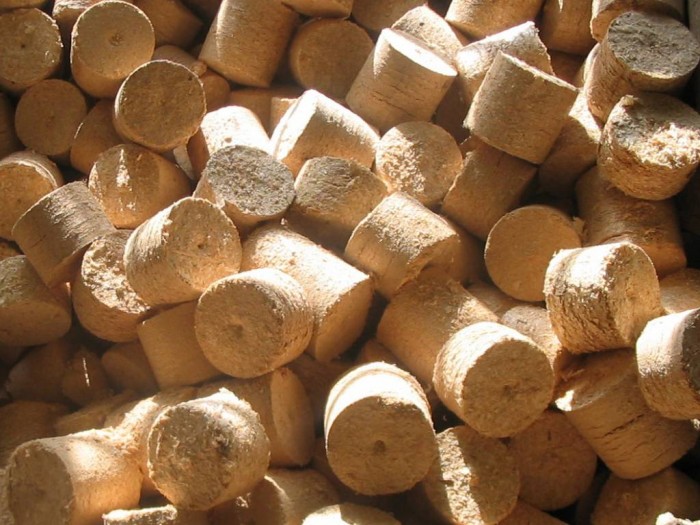
The density of the wood is not the same, it all depends on the original wood species from which it was obtained. It is also important that a small amount of ash remains during the combustion of a wood heating briquette. Its indicator does not exceed 0.12%. While coal leaves behind 20% ash. Wood briquettes for heating are convenient because there is no crackling at the moment of burning, and they do not give off a spark. The formation of smoke is minimal and with all this, this type of fuel is able to give off heat to the room for several hours. The block will completely burn out in 4 hours. If you don't remove ash and coals, you can use them for cooking.
The most important thing in this type of fuel is that heating with sawdust with your own hands is safe in all respects for humans.
If you compare it with coal, when burning, wood gives many times less carbon monoxide than other materials. The form in which the wood blocks are produced is convenient in practice. This saves space for fuel storage. Eurodroves are suitable as fuel not only for solid fuel boilers. They can be used for making a fire in nature and for kindling a fireplace. Also, firewood in the form of wood blocks is easy to control in consumption.
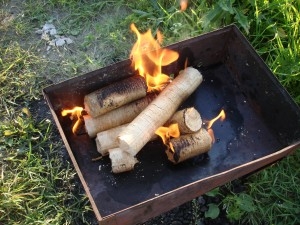
You can calculate how many blocks you need to heat a certain area. Knowing this value, easily specify the amount of fuel purchased for the season. Remember, when buying solid wood, you pay not only for the material, but also for water and air. As you can see, heating with pressed sawdust is not only beneficial from an economic point of view, but also safe in terms of health. You also have the opportunity not to cut down forests and other green spaces in order to heat the house with sawdust.
Peat briquettes are produced in the same way as wood briquettes. Peat is initially dried and pressed. If peat is influenced by high temperatures, it begins to thicken and turns into blocks. This form is convenient for storage and delivery of goods. Peat briquettes can be used to heat all types of ovens. This type of fuel is characterized by high heat transfer rates for a long time. As you can see, peat briquettes for heating are another option for replacing solid wood for space heating. If your boiler allows you to regulate the air supply, then the burning time of the peat blocks is increased to 8 hours.
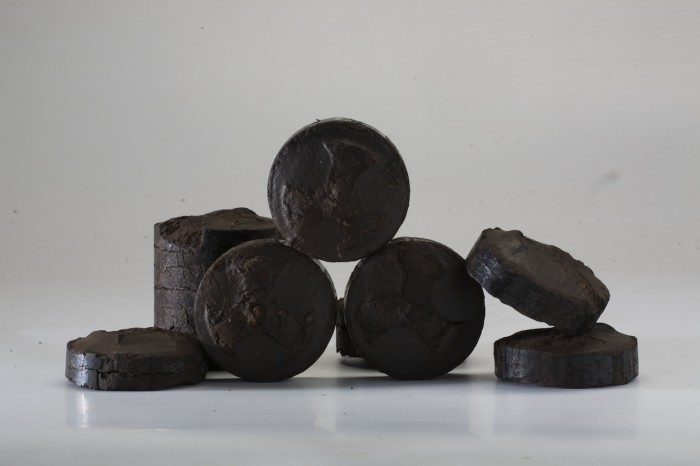
This fuel will be a good substitute for other fuel options for heating rooms at night. At this time of the day, it is important for you to keep the air temperature in the room at a comfortable level for normal life. Let us recall the form again. Peat briquettes for heating - a small form for easy transportation and for melting the oven. In order for the boiler to constantly heat the water, it is enough to add new briquettes at regular intervals.
The ash after the combustion of the peat briquette can be used as fertilizer for phosphorus fertilization of plants on the site.
This fertilizer alternative will appeal to many gardeners. Let's consider which is more profitable - firewood or pellets. To buy a ton of peat blocks, you have to pay about 6,000 rubles. A ton of firewood of any kind of wood costs 2,000 rubles. Let's recalculate the heat transfer rates of these materials. It turns out that 2.4 kWh / kg gives firewood and 5 kWh / kg, we have an output from the combustion of pellets. As you can see, it is much more profitable to purchase artificial fuel. Also, the practicality of peat briquettes is that there is no need to chop firewood into convenient logs, dry them and allocate large areas for storage.
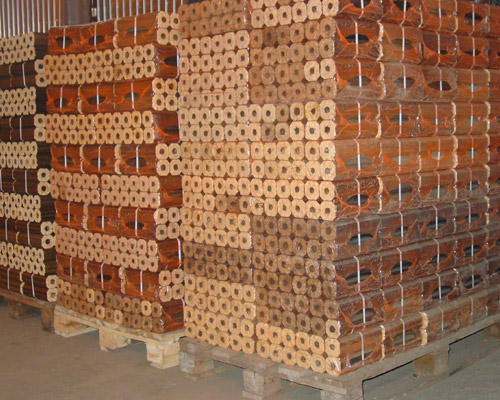
Coal briquettes
It would be more accurate to say that coal briquettes for heating are made from compressed coal dust. Several types of non-natural fuels are produced from it. It is important to sift through the dust before starting production. Then it is crushed and sent for pressing. In order to form a coal dust briquette, a viscous substance is used. The result is a briquette fuel based on coal.

Coal briquettes
It is no secret that coal is the only material for a furnace that does not form smoke when burned. He also falls into the group of safe fuel. Therefore, charcoal can be used as a heat source when cooking inside a building using barbecues and grills. As for catering facilities, the strictest rules are presented here to avoid sunburn and poisoning.
Coal heating briquettes can burn for 7 hours. The main condition for long-term combustion is the fact of controlled air supply to the furnace.
Such conditions will free you from being constantly near the stove. In this case, you can add briquettes to the oven three times during the day.
What is the difference between solid fuel and other heat sources?
By using coal briquettes, you do not pollute the environment with carbon dioxide. When peat or wood is burned, carbon dioxide is released more than when coal is burned. Also, coal does not form sulfur dioxide and other foreign impurities that are undesirable for the body. Using charcoal briquettes for heating with your own hands, you can heat the room better, because the efficiency reaches 95%.

When burning fuel briquettes, much more heat is generated than when using conventional fuels
When a coal briquette is burned, ash is formed at the outlet. Its indicator does not exceed 1% of the total volume of burned fuel. Actively coal can burn only for 40 minutes, then the stage of material smoldering follows. Its duration has been calculated and is up to 3 hours.
Switching to charcoal briquettes will allow you to add fuel to the stove only three times a day.
If you have already tried to heat with wood briquettes, you must agree that the smoke coming from the stove resembles the smell of fresh wood in nature when it naturally burns. This kind of material does not lead to the development of allergies.
How are fuel briquettes prepared and transported?
As you can see, during the production of briquette fuel, combustion rates increase, which makes artificial fuel a good alternative to coal.
To melt the stove with peat, it must be dehydrated and thoroughly crushed. The production of briquettes for heating and peat processing is located near his deposit. Hence, the cost is not high, since there is no need to transport it from deposits to the place of processing. The costs of producing peat briquettes are low, therefore the retail price is low. The cost is affected by the cost of transport services. In the entire production scheme, this stage is the most costly. As you can see, the convenient form of the finished material allows you to transport large volumes compared to their original sources.
Briquette fuel storage methods
Pressed briquettes for heating must be stored according to strict rules. It is necessary to monitor the humidity level in the warehouses. Its indicator should not exceed 80%. There is no need to build insulated hangars for this. It is enough to renew the roof over the canopy. Due to the fact that the fuel has a high density, the small area of \u200b\u200bthe room allows you to store significant stocks of briquettes. One cubic meter holds up to 2500 kilograms of fuel.
There is no need to equip warehouses with strict adherence to safety precautions, since the fuel in the briquettes cannot be ignited. Also, there is no release of third-party gases and other toxic substances.
Fuel in briquettes does not absorb excess moisture, therefore it is able to maintain high performance for a long time.
Briquetted fuel has received excellent reviews and is widely used in heating suburban real estate, heating baths, saunas. Ideally keeps the air temperature at the set values \u200b\u200bin fireplaces and stoves. It is also recommended to use it for heating greenhouses and farm buildings. This type of fuel can be used for kindling boilers for any purpose. As you can see, briquetted fuel is not only an economically profitable, but also an efficient source of heat.




